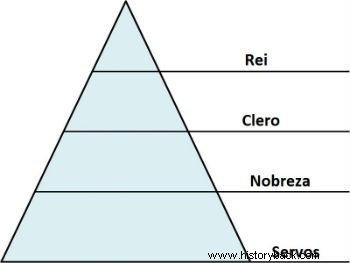Thefeudal society is the one that developed during the period of feudalism, a system that prevailed in Europe between the 10th and 15th centuries.
Feudal society was essentially rural based on the fief (land) and inserted in a monarchical system of decentralization of power.
It was marked by agrarian and subsistence production, where servile work and the influence of Christianity predominated.
Features:Summary
Feudal society was characterized by being an estate society, that is, a fixed hierarchical social structure that was divided into estates.
Estates represented social groups or states and, in the case of feudalism, were basically divided into four instances:
- King and nobility :the kings stood out in the nobility, but they were part of it and needed to make alliances with other nobles in order to govern. This category included warriors.
- Clergy :represented the layer related to the sacred, that is, those who prayed and strengthened the Catholic religion (popes, bishops, cardinals, monks, abbots and priests). In short, it was the class that held the power of the Church (the most powerful feudal institution) and the one that knew how to read and write.
- Servants :encompass the villains, peasants and serfs, that is, those who worked in the manors (food production and buildings) in exchange for housing, food and protection.
 Representation of the Feudal Social Pyramid
Representation of the Feudal Social Pyramid
The nobility and clergy ruled the manors and received taxes from the serfs.
In this system, social mobility was almost non-existent, that is, the born would belong to the same group until their death. In short, social position was defined by birth:he was born a servant, he will live as a servant all his life.
In addition, feudal society was marked by the relationship of suzerainty and vassalage. Thus, between the suzerain and the vassal, there was a commitment of fidelity between nobles, which implied reciprocal rights and obligations.
The suzerains, owners of land, donated them to the vassals, who in turn were in charge of looking after and protecting them.
This whole model was based on life in manors, large tracts of land that had their own economic, political, social and cultural organization. Each fief had its army, its way of collecting taxes and in some cases even its own currency.
It is not by chance that we call this period of the Middle Ages feudalism.
There, feudal lords represented the ultimate power in each manor, administering and enacting laws, while serfs worked their land and warriors defended it.
Learn more about the topic :
- Feudal Economy
- Crisis of Feudalism
